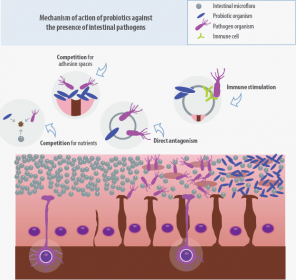
To read more content about AviNews-América Latina Sep 2015
To read more content about AviNews-América Latina Sep 2015
Contenido disponible en:
Español (Spanish)
NUTRITIONAL VALUE OF PROBIOTICS
THE HUGE INCREASE OF GROWTH POTENTIAL OF CHICKENS HAS CONCURRENTLY GENERATED AN INCREASE IN NUTRITIONAL NEEDS
Progress in knowledge of the composition and effect of raw materials used in animal feed implies a tremendous progress on the road towards a sustainable and efficient animal production.
Furthermore, the use of new ingredients opens windows for substituting raw materials which previously “tyrannized” formulations.
On the other side of the coin, digestibility of these new alternatives is sometimes not equivalent, therefore the use of a whole new range of additives which may release all nutritional potential of these new diets is necessary.
Also, genetic screening has produced animals having a tremendous growth potential, and a worthwhile data is the fact that the final weight gain (on 56d) of broilers has increased by 132% from 1978 to 2005.
Accordingly, a new range of natural growth promoters occupies the niche created by the new challenge.
Traditionally, this field had been occupied by growth-promoting antibiotics. At present, this group of additives is in the spotlight as main suspects of generating drug-resistant pathogens. The FAO (Food and Agriculture Organization) in its last report- Antimicrobial Resistance Global
Report on Surveillance 2014- estimates 25.000 human deaths per year in Europe caused by these antibiotic-resistant pathogens, besides the cost imposed on society by these conditions which is 1500 million euros per year (ECDC 2007).
For this reason, and the suspicion of the abusive use of growth-promoting antibiotics, they are being gradually withdrawn from the market in all continents.
The huge impact of antibiotic resistance compels us to seek alternative strategies in the field of nutrition
Within the new “class” of natural growth promoters we can find different categories: short- and medium-chain organic acids, prebiotics, essential oils and probiotics.
Due to the combination of different beneficial effects which they may exhibit, probiotics are increasingly gaining attention of animal nutrition professionals from the whole planet.
Probiotics inhibit pathogen growth not generating antibiotic resistances- through disruption mechanisms of the quorum sensing and bacteriocin, lactic acid synthesis, etc.- promote beneficial flora, play an important role in the development and structure of the intestinal epithelium and positively affect the immune response modulation.

OWN FUNCTION AND ENZYMATIC ACTIVITY
Probiotics, as most bacteria, metabolize in the medium where they are to be found, thanks to their own enzymatic system.
To this effect, they synthesize and excrete a great variety of enzymes specialized in degrading complex compounds such as: long-chain carbohydrates, proteins and fats.
Products of this metabolism are used as energy source or as structural components in their growth and reproduction.
Enzymatic activities of each probiotic species differ, having very variable metabolic efficiencies when facing substrates in which they grow in each case.
EXAMPLE
In the case of Bacillus amyloliquefaciens, its great capacity to produce enzymes has been used in different industrial fields.
As examples, the use of this species for benefiting from its amylases in industrial processes of sugar and paper is known (Zar et al. 2012) as well as its proteases in waste treatments, detergent and drug production (Schallmey et al. 2004), and its lipase excretion is central in the manufacture of milk-derived products (Selvamohan et al. 2012).
Industrial use of these enzymes is attractive due to its high extracellular secretion rate and its considerable thermostability (Schallmey et al.
2004).
PROBIOTICS AND DIGESTIBILITY IMPROVEMENT
With all this information in hand, we can hypothesize that this extracellular enzymatic production may enhance digestibility of a feed when providing the probiotic in combination with the diet.
In this respect we may find, in scientific literature, examples which support this hypothesis, such as the test carried out by Sanchez et al. (2006) wherein it was demonstrated how the use of B. amyloliquefaciens CECT5940(2) enhanced digestibility of crude protein, ether extract and starch in broiler diets (See Table 1).
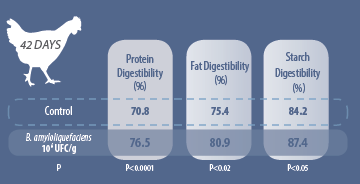
Table 1. Effect of probiotics on digestibility of protein, fat and starch in 42 day-old broilers (Sánchez et al., 2006)
Extracellular enzymatic production of probiotics may increase the diet digestibility.
COULD WE REDUCE THE NUTRITIONAL CONCENTRATION OF THE DIET WITH A B. AMYLOLIQUEFACIENS CONTRIBUTION?
PROPOSAL
Knowing this digestibility enhancement of the diet due to the additive effect (see the test described on the previous page), the question arises as to whether making use of this benefit we might reduce the nutritional concentration of the feed compensating this decrease with the probiotic action. In this manner we could increase flexibility of the formulation requirements thereby lowering the final price of the feed.
480 Chickens (Arbor Acres Plus) in total were randomized in 8 different treatments with 6 replications using 10 fowls per cage as experimental unit (3).
The experimental period covered the initial phase (0-18 days of age) and the growth phase (18-35 days of age).
Feeds were prepared in pellets (conditioned at 80ºC) and delivered as crumbs up to the age of 12 days and then as pellets until the end of the test. Water and feed were offered ad libitum.
During the test, the specific handling recommendations for the lineage Arbor Acres Plus were used.
Chicken weight and feed leftovers were measured on days 18 and 35.
Mortality and discards were recorded daily. At the end of each period, the individual weight was measured in order to calculate group uniformity.
Weight gain, feed consumption, feed Conversion, viability and uniformity were statistically analyzed by ANOVA in a factorial design 4 x 2 RCBD.
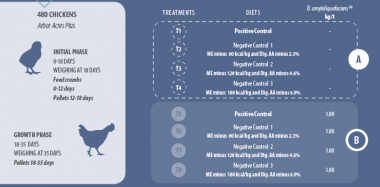
Table 2. Experimental design – ME Metabolizable Energy – Dig. AA Digestible Amino Acids
(3) The study was carried out in BARC (Bangkok Research Center), Thailand
(4) B. amyloliquefaciens CECT5940 (ECOBIOL®)
Additionally, a digestibility study was carried out in order to confirm that the compensatory effect of the probiotic may be attributable to the digestibility increase of the nutrients.
For this purpose, 240 21 day-old male chickens were used. Animals were distributed in 48 metabolic cages (5 fowls/cage).
The same diets were used as those in the growth test which resulted in 6 replications per diet.

INTAKE CALCULATION
During the 96-hour duration of the test, the amount of feed given and leftovers were measured in order to calculate the intake.
EXCRETA ANALYSIS
Excreta were daily collected and then dried at 80ºC for 24h.
Dry matter content was analyzed (105ºC, 4h) as well as gross energy (GE) (bomb calorimeter, Leco
model AC-350, method Isoperibol).

Formula 1. Calculation of apparent metabolizable energy AME. GE = Gross Energy

Formula 2. Calculation of apparent metabolizable energy corrected to zero nitrogen retention
AMEn. GE = Gross Energy.
With the following NR values = Nitrogen retention:
(20% body weight gain)/6.25 and k is the constant:
8.21 kcal/g retained nitrogen
Apparent metabolizable energy (AME (6)) was analyzed and corrected metabolizable energy for zero nitrogen retention was calculated (AMEn (6)).
All diets used in the study of AMEn (6) and digestibility were added a marker
6) AME = Apparent Metabolizable Energy
AMEn Apparent metabolizable energy at zero nitrogen level
GE = Gross Energy
ILEUM ANALYSIS
Upon finalization of the above-mentioned 96-hour study, all fowls were slaughtered in order to obtain samples of ileum content.
Samples were lyophilized and then analyzed for protein and marker content.
Apparent ileum digestibility of the protein based on dry matter is calculated according to formula 3.

Formula 3. Calculation of apparent ileum digestibility of crude protein
AIDCP = Apparent ileum digestibility of crude protein
CPd = Crude protein concentration in the feed
CPi = Crude protein concentration in the ileum content
Crd = Marker concentration in the diet
Cri = Marker concentration in the ileum content
RESULTS
In this document, we will stick to the results obtained in the first part of nutrient reduction (7).
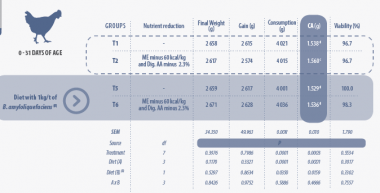
Table 3. Effect of B. amyloliquefaciens (8) on production parameters (0-35 days of age). FC = Feed Conversion.
ME = Metabolizable Energy. Dig. AA = Digestible Amino Acids. SEM = Standard Error of the Mean.
a,b,c,d,e Means of the same column with different superscripts are significantly different (p<0.05)
(/) For more information, complete study results were presented in the following conferences of animal nutrition: APPC 2015 (Jeju) Abstract PP-0555;
IPSF 2015 (Atlanta) Abstract T-209.
(8) B. amyloliquefaciens CECT5940 (ECOBIOL®)

Table 4. Effect of B. amyloliquefaciens (8)
Effect of Ecobiol on metabolizable energy and nutrient retention (24-28 days of age)
SEM =Standard Error of the Mean. AMEn = Apparent metabolizable energy corrected to zero nitrogen retention. DM = Dry Matter
a,b,c,d,e Means of the same column with different superscripts are significantly different (p<0.05)
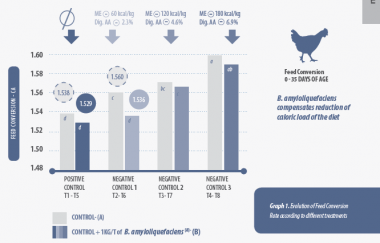
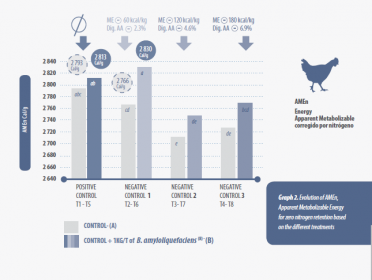
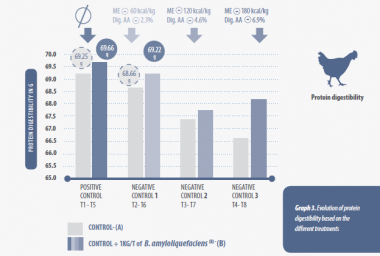
We can see from the results how B. amyloliquefaciens (8) – improved FC compared to similar nutritional content diets.
Also, said nutrient reduction produced a performance worsening, which made it clear that the chosen reduction did have a clear effect on the animal performance. Starting from that feed conversion worsening, we can see as the group receiving probiotic supplement had a FC improvement compared to the group receiving the same nutrient concentration without supplement.
Use of B. amyloliquefaciens CECT5940 compensated the reduction of 60 kcal/kg and 2.3% digestible amino acids (lysine and methionine) without worsening growth parameters, reversing performance to the results of the group which received the feed with the complete nutrient content.
As noted earlier, this compensatory effect may be explained by the higher values of metabolizable energy retention and protein digestibility observed in animals supplemented with B. amyloliquefaciens (8).
We can conclude that this probiotic is capable of making up for reductions in energy and amino acid concentration in the diet.
Based on this knowledge and knowing that use of this bacillus produces this compensatory effect, we can give the additive a hypothetical nutritional value capable of yielding in a formulation software the equivalent to the values confirmed in the test, that is, a release of up to 60 kcal/kg and a 2.3% digestible amino acids.
In this manner, this extra nutrient contribution would be taken into account by the formulation software increasing the flexibility of the specifications and lowering the price of the calculation result.